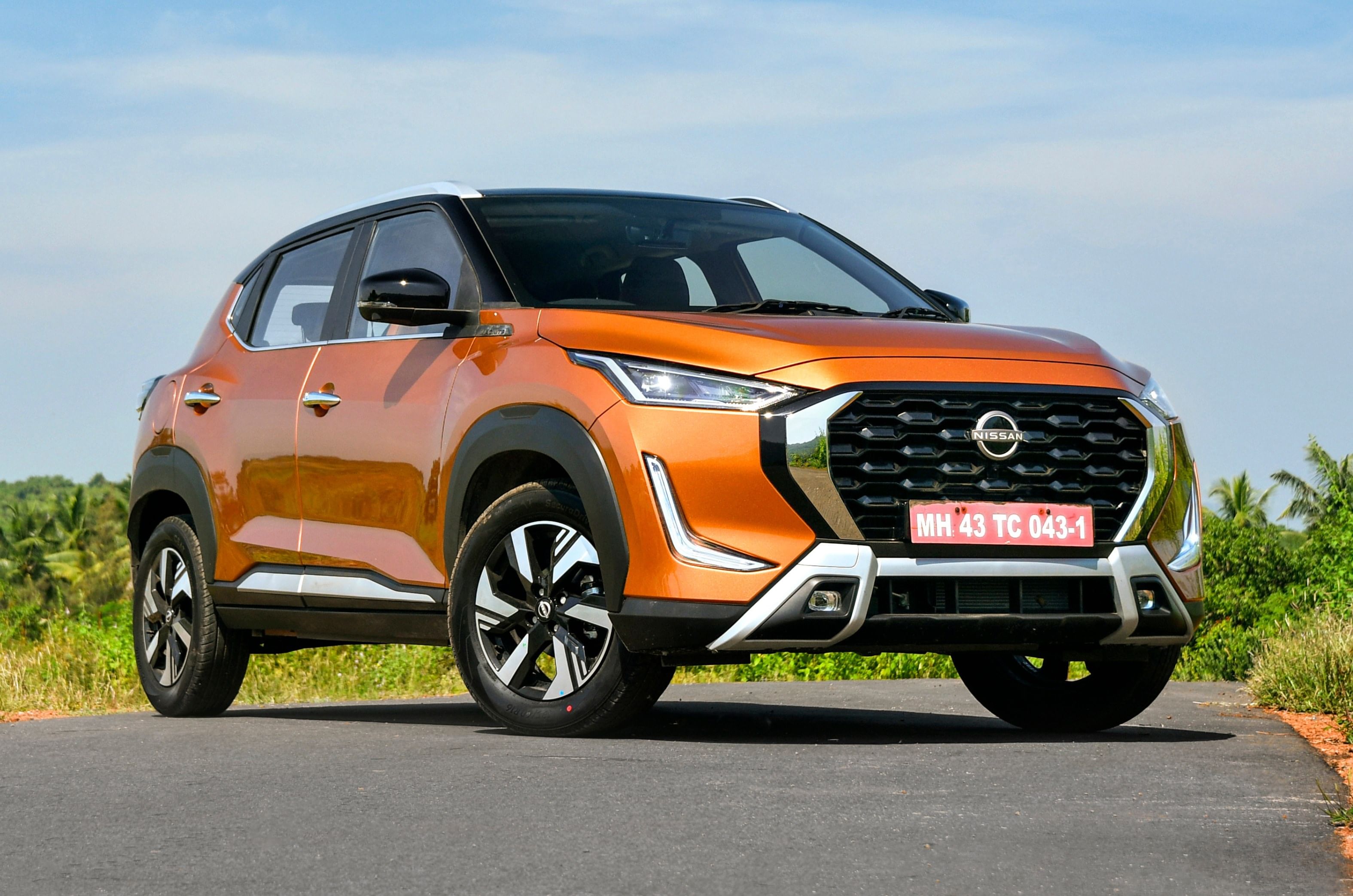Nissan Magnite facelift review: Small changes, big effect
Do the fresh face, updated interiors, and added features make the Magnite an even better value buy? We find out.
Published on Oct 18, 2024 01:25:00 PM
35,826 Views
We Like
- Appealing interiors
- Value for money
- Turbo-petrol's punchy performance
We Don't Like
- Refinement
- Missing some modern features
It’s been nearly four years since Nissan brought the Magnite to India, and the compact SUV has shouldered the responsibility of establishing the Japanese brand's presence in the country. The X-Trail is a recent addition, serving more as a brand statement than a bread-and-butter model. Over the past six months, Nissan has despatched more than 12,000 units of the Magnite to its dealers (over 2,000 units every month) and has exported over 30,000 made-in-India models to international markets in the past four years.That the compact SUV will have to soldier on here, combined with the company's aim to export nearly 1 lakh units to 65 left-hand and right-hand-drive markets by 2026, underscores that a lot is riding on this facelift.
Nissan Magnite facelift: exterior, design
While the changes to the Magnite facelift’s design may seem insignificant when seen individually, together they add a dose of ruggedness to the compact SUV. The addition of a piano black appliqué that connects the grille and headlights makes the former look larger. The front bumper gets contrasting silver bits that protrude slightly, adding to the muscular appearance and also serving as fog light housings.

The new, smart-looking dual-tone 16-inch alloys add some freshness to the sides of the Magnite. The tail-lights get new 3D LED signatures that are quite attractive. Also, the Sunrise Copper Orange exterior colour is new and suits the Magnite well, especially with the contrasting black roof.
Nissan Magnite facelift: interior
It’s a similar story on the inside – there are small changes, but the effect is notable. The Magnite facelift’s cabin looks and feels far more premium, thanks to the copper-coloured leatherette finish on the dashboard and door panels, especially compared to the outgoing model’s nearly all-black plastic finish. The steering now gets an all-black finish that contrasts well with the dash, and the seats in the top-spec Tekna+ variant come in dual-tone copper-black leatherette covers that help keep one’s back and bottom cool, especially in conjunction with the strong automatic climate control system.
However, not everything is perfect. The new ambient lights do add to the ambience, but the execution could have been a bit more seamless. In addition, the steering column is visible in the footwell, and the accelerator and brake pedals are placed a little too close together.
In terms of practicality and comfort, the Magnite facelift retains its ability to carry four passengers with ease – though three seated abreast in the back will find shoulder room lacking – and comes with a 336-litre boot, which is good enough for a couple of large suitcases, and expands to 690 litres with the rear seats folded.
Nissan Magnite facelift: features
The faceliftcomes with a slightly expanded feature list. The Magnite has always been a well-equipped compact SUV, and it now adds goodies like engine remote start, auto headlights, an auto-dimming IRVM (the frameless unit picks up fingerprints and smudges too easily), a cooled glove box, and a USB C-Type port for rear passengers. The updated 7-inch digital instrument cluster is less gimmicky than that of the outgoing model, yet it displays the same amount of information, making it a welcome upgrade.
The standard safety kit on every Magnite variant includes six airbags, three-point seat belts for all passengers, ISOFIX anchors, ABS, traction control, a tyre pressure monitor, and a hill-start assist. The higher Techna and Techna+ variants also get a 360-degree camera, which doesn’t have the best resolution but works effectively.
Nissan Magnite facelift: performance, ride and handling
The Magnite is still offered with either a 72hp, 1.0-litre naturally aspirated petrol engine or a 100hp, 1.0-litre turbo-petrol unit; we’ve driven the latter, and it’s just as enjoyable as before. This three-cylinder unit has a strong mid-range punch and works well with the smooth CVT to mask any lag at lower revs. Speaking of the CVT, at low and medium engine speeds, there’s barely any of that typical ‘rubber band’ effect, but if you drive with a heavy right foot, it will set in. Cabin insulation has improved marginally, but the three-pot engine’s clatter is still audible, and it gets boomier as the revs rise.
At slower speeds, there is an underlying firmness to the Magnite’s suspension setup, but it doesn’t feel uncomfortable at any point. On the highway, the suspension does a much better job of filtering out road undulations, making it an able cruiser. What also helps is the steering that weighs up as the speeds rise, and the 195/60 tyres offer a decent amount of grip, instilling confidence when going through twisty ghat sections. On the other hand, despite doing a good job, the brakes don’t lend as much confidence as they should as the pedal feel is mushy, and there’s some slack before the brakes bite.
Nissan Magnite facelift: price, verdict
On the face of it, it may seem like not much has changed with the Magnite facelift, but that’s not true. It retains all the qualities of its predecessor –brilliant design, comfort, a sporty feel, and a well-equipped interior, all with an attractive price tag– while showing marked improvements in areas such as interior ambience and feel-good features.
Other than the visible cost-cutting and the lack of a sunroof at this price point (models such as the Venue, Nexon, and XUV 3XO offer one at the Rs 11.50 lakh that this top-spec Tekna + variant retails for), the Magnite is a more than competent package, especially when one considers that you pay just Rs 23,000 more for it compared to the outgoing model’s top-spec trim. The Magnite model should help Nissan maintain a foothold in India, at least for the near future.
All prices, ex-showroom, India
Also see:
Nissan Magnite: new versus old
Nissan Magnite facelift price, variants, features explained
Related Videos
Tech Specs
| Price | Petrol AT |
|---|---|
| Ex-showroom - Delhi | Rs 11.5 lakh |
| Warranty | 3 years/1 lakh km |
| Engine | Petrol AT |
|---|---|
| Engine Installation | Front, transverse |
| Type | 3-cyl, turbocharged |
| Cubic Capacity (cc) | 999cc |
| Bore/Stroke (mm) | 72.2/81.3mm |
| Max Power (hp @ rpm) | 100hp at 5000rpm |
| Max Torque (Nm @ rpm) | 152Nm at 2200-4400rpm |
| Transmission | Petrol AT |
|---|---|
| Drive Layout | Front-wheel drive |
| Gearbox Type | CVT |
| Efficiency | Petrol AT |
|---|---|
| Claimed Indian Driving Cycle (kpl) | 17.9kpl |
| Tank size (lts) | 40 litres |
| Body | Petrol AT |
|---|---|
| Weight (kg) | 1103kg |
| Front Tyre | 195/60R16 |
| Rear Tyre | 195/60R16 |
| Spare Tyre | 165/80R14 |
| Suspension | Petrol AT |
|---|---|
| Front | Mac Pherson strut with Lower Transverse link |
| Rear | Twin tube telescopic shock absorber |
| Steering | Petrol AT |
|---|---|
| Type of power assist | Electric |
| Turning Circle Diameter (mts) | 10m |
| Brakes | Petrol AT |
|---|---|
| Front | Disc |
| Rear | Drum |
| Dimensions | Petrol AT |
|---|---|
| Length (mm) | 3994mm |
| Width (mm) | 1758mm |
| Height (mm) | 1572mm |
| Wheelbase (mm) | 2500mm |
| Ground Clearance (mm) | 205mm |
| Boot Capacity (Lts) | 336 litres |
Copyright (c) Autocar India. All rights reserved.


